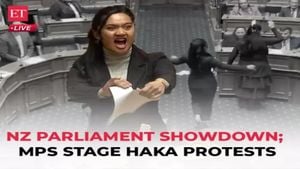Every November, as the leaves start to fall and the air grows brisk, people across the UK and Canada gear up for one of the most meaningful days of the year: Remembrance Day. This solemn occasion, dedicated to honoring those who made the ultimate sacrifice for their countries, has become both a cherished tradition and, recently, a hotbed of controversy. From the symbolism of the poppy to the nuances of what it means to honor our veterans, divergent views have sparked both deep reflection and heated debate.
Remembrance Day origins trace back to the end of World War I, inspired by the significant events of November 11, 1918, when hostilities ceased. The poppy has emerged as the iconic symbol of this day since the publication of John McCrae’s poem, "_in Flanders Fields_" which depicts the vibrant flowers growing amid the graves of fallen soldiers. The poppy, it seems, holds layers of meaning—life blooming from tragedy, remembrance blended with beauty. Yet its significance has recently been challenged within public discourse, sparking questions on who gets to wear it and why.
One source of contention has been the notion, presented by some on social media, which equates the poppy with conservative ideology. A TikTok user argued it has become “a conservative dog whistle,” discrediting the memory of those who lost their lives by associatively labeling poppy wearers as right-wing individuals. This assertion was met with strong backlash, particularly from those who argue the poppy transcends political affiliation. Critics assert it is simply about honoring the sacrifices made, not about signaling support for any political agenda.
One passionate response came from writer James Jobson, who challenged the TikTok user, emphasizing the poppy's role as a symbol of remembrance devoid of any political undertones. According to Jobson, wearing the poppy signifies respect for the lives lost, regardless of the wearer's personal beliefs. He went on to highlight the enduring legacy of the poppy, explaining how it invites all of us to reflect on the cost of war and the fragility of peace. “Every year, I wear the poppy, not because I subscribe to any ideology, but to honor,” he stated.
This sentiment resonates deeply, especially as the last of the World War I veterans pass away. The media frenzy surrounding their stories has sparked what some have called “remembrance hysteria,” with extravagant displays of reverence often overshadowing the very human heartbreak and sacrifice behind this tradition. Commemorative events such as the Tower of London’s large-scale light show have incited mixed reviews on whether such spectacles serve to honor or commercialize the memories of lost heroes.
Within the Canadian experience, similar public debates have emerged. Conservative Leader Pierre Poilievre recently stirred controversy by labeling certain Remembrance Day event organizers as overly 'woke', following events where discussions of diversity and inclusion, including recognition of Indigenous peoples, were interwoven with traditional ceremonies. He criticized the inclusion of themes like the transatlantic slave trade during these somber observances, asserting such discussions detract from the day’s primary purpose: honoring military veterans.
His remarks were compounded by reactions from veterans like Sean Bruyea, who claimed such actions dilute the solemnity of Remembrance Day. Bruyea criticized instances where traditional remembrance practices were altered or misrepresented—for example, the Ottawa school decision to play songs considered politically charged during its Remembrance Day ceremony—asserting they undermine the essence of the day and offend veterans and families alike.
Yet, across the board, there are voices advocating for evolution rather than stagnation. Historian Jonathan Vance noted the need for inclusive approaches to Remembrance Day, acknowledging its evolution as society changes. “Traditions can evolve,” Vance said, emphasizing the significance of recognizing diverse contributions to Canada’s military history, including those from Indigenous Peoples and other racial groups. He suggested this inclusivity not only keeps the day's observances relevant but enriches the shared narrative.
Indeed, Vance pointed out how public sentiment toward Remembrance Day remains remarkably strong, reflected by large gatherings at memorial services this year, even amid inclement weather. “Anecdotal evidence suggests people still deeply value the observance—witness the numbers attending,” he noted, underscoring the importance of acknowledging veteran sacrifices as part of the Canadian identity.
This necessity for open dialogue has not only surfaced among the public and politicians; it has reverberated through media narratives as well. Media outlets continuously report on the various tensions surrounding Remembrance Day, evoking discussion and debate. Presenter and cultural commentator Juliet Jacques remarked on the juxtaposition of contemporary interpretations of war and remembrance practices. “What we see is largely shaped by historical narratives written through the lens of political agendas,” she explained, encouraging audiences to critically engage with these representations.
Digging deep, the discussion is undeniably complex. The juxtaposition of honor, memory, and ideology creates fertile ground for misunderstanding and conflict. At the heart of this discourse rests the poppy itself—a flower symbolizing not just war and loss, but resilience and hope for peace. While some want to politicize it, others wish to keep it as pure as its original intent.
The explosion of social media commentary and public reaction to traditional ceremonies reflects deep-seated feelings around memory, identity, and patriotism. It begs the question: what does it mean to honor those who served and sacrificed? And can there be room for everyone’s story within our collective remembrance? Each year as Remembrance Day approaches, Canadians and the British reflect on these very questions, pondering the best ways to honor those who wore their country's uniform and paid the ultimate price for freedom.
What remains clear is the need for empathy and concerted efforts to understand various perspectives surrounding these deeply held traditions. Embracing comprehensive dialogues about what remembrance means can only serve to add richness to this time-honored ritual—ensuring the day stays relevant for generations to come. By honoring the memories of veterans, we transform the observance itself; it becomes not merely about commemoration, but about the lessons learned, the identities shaped, and the path forward as a diverse society.
For now, it’s evident: the conversation about Remembrance Day will continue to evolve, with voices from all sides playing their parts. And perhaps, within these diverse narratives, the true spirit of remembrance can thrive.



